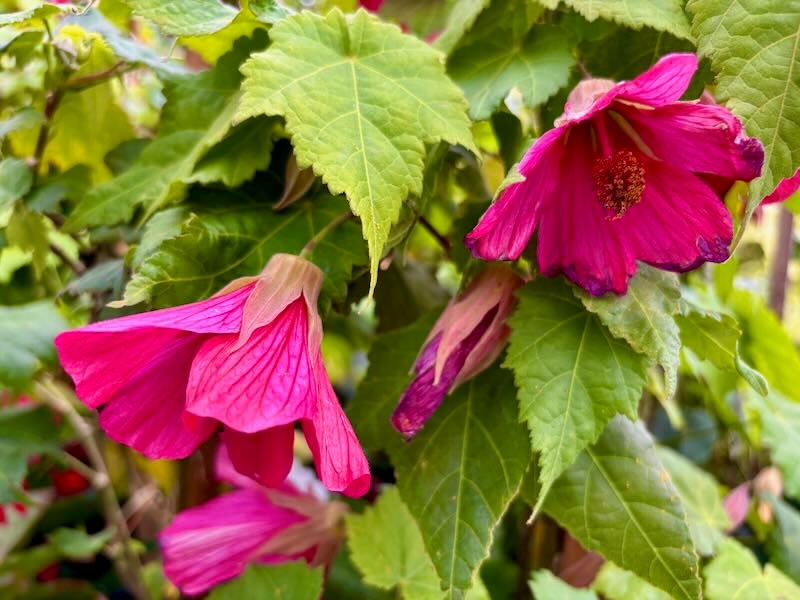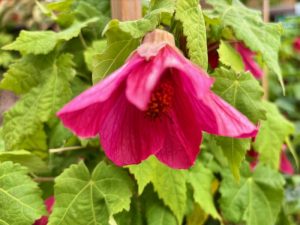Abutilon ‘Scarlet Fire’: A Striking Cascade of Scarlet Bells
Abutilon ‘Scarlet Fire‘, or Abutilon hybridum ‘Scarlet Fire‘ commonly known as Flowering Maple or Chinese Lantern, dazzles with its brilliant scarlet blooms and maple-like foliage. This hybrid shrub stands out in mild-climate gardens where it behaves as a soft-stemmed evergreen, producing nodding, bell-shaped flowers through much of the year. Hummingbirds often find it irresistible, darting from flower to flower in search of nectar. Despite its tropical origins, this cultivar has become a garden favorite for temperate zones due to its adaptability, long flowering season, and bold color.
Reaching mature dimensions of 8–10 feet (2.4–3 meters) tall and wide in optimal conditions, Abutilon ‘Scarlet Fire’ fills vertical and horizontal garden space with soft, mid-green leaves that resemble miniature maple foliage. This texture and form make it an excellent candidate for informal hedges, mixed borders, or as a striking container specimen. In cooler climates, it may grow more modestly, topping out around 2–4 feet (0.6–1.2 meters) if overwintered indoors or treated as a tender perennial.
The Allure and Origins of Abutilon hybridum ‘Scarlet Fire‘
While the specific breeder of Abutilon hybridum ‘Scarlet Fire’ remains undocumented, it is recognized as a selection from the Abutilon hybridum group—a lineage of hybrid flowering maples derived from species native to South and Central America, Africa, and Australia. These plants belong to the Malvaceae family, which includes other ornamental and agricultural favorites such as hibiscus, hollyhocks, and okra. Like its relatives, Abutilon thrives in warmth, appreciates generous water during growth, and rewards gardeners with showy blooms from spring through fall.
Within the Malvaceae family, Abutilon exhibits the typical bell-shaped, five-petaled flower structure, paired with a long central column of fused stamens—a signature trait of the mallow clan. The genus name Abutilon comes from Arabic and was adopted into Latin by early botanists to describe these decorative and somewhat shrubby perennials. ‘Scarlet Fire’ continues the tradition of flamboyant flowering seen in many species of this genus, distinguished by its deep scarlet coloration and graceful drooping habit.
How to Grow Abutilon hybridum ‘Scarlet Fire‘
Light
Abutilon ‘Scarlet Fire’ flourishes in dappled light or partial shade, especially in hot-summer regions. It tolerates full sun in coastal or mild inland climates but benefits from afternoon shade where summers are intense. Indoors, place it near a bright south- or west-facing window for best results.
Soil
This flowering maple thrives in rich, well-draining soil with good moisture retention. A loamy mix with compost or aged manure works best. For containers, use high-quality potting soil amended with perlite or sand to improve drainage. Avoid heavy clay soils unless modified, as soggy conditions may lead to root rot.
Watering
Once established, Abutilon hybridum ‘Scarlet Fire’ has moderate water needs. During summer, especially in containers, water regularly to maintain even moisture without saturating the roots. The top inch (2.5 cm) of soil should dry out slightly between waterings. Avoid letting the soil dry completely, which can cause wilting and bud drop.
Fertilizing
Regular feeding supports the extended bloom cycle. Apply a water-soluble fertilizer every two weeks during active growth. Use a balanced formula like 18-18-18 or a bloom booster such as 10-30-20 to encourage flowering. Reduce or stop fertilizing in winter when growth slows, particularly if overwintering indoors.
Pruning
Prune in early spring to shape the plant, remove leggy growth, and stimulate fresh shoots. Cut back by up to one-third if needed. Throughout the season, deadheading spent blooms will encourage new buds. For container-grown plants, pinching young stems helps create a denser, more compact form.
Temperature
‘Scarlet Fire’ prefers warm, temperate conditions. Ideal daytime temperatures range from 65–75°F (18–24°C). Though considered evergreen in USDA Zones 9–11, it may suffer frost damage below 30°F (-1°C). In colder areas, bring potted plants indoors before the first frost, placing them in a bright, cool room.
Pests and Diseases
While relatively low-maintenance, Abutilon ‘Scarlet Fire’ is susceptible to several common pests. Aphids, whiteflies, spider mites, and scale may appear, especially on indoor plants. Use neem oil, insecticidal soap, or horticultural oil for control. Good air circulation, regular inspection, and clean watering practices help prevent infestations.
Disease concerns include root rot, rust, and leaf spot, all of which relate to excessive moisture or humidity. Provide well-draining soil, avoid wetting leaves, and thin the canopy to improve airflow. In some cases, fungal diseases can be managed with copper-based fungicides or sulfur sprays.
Overwintering and Additional Tips
In cooler zones, overwinter Abutilon ‘Scarlet Fire’ indoors in a pot, reducing water and keeping it in bright, indirect light. Alternatively, grow it as an annual and replant each spring. To propagate, take softwood cuttings in late spring or summer and root them in a moist, sterile medium.
An interesting characteristic of Abutilon is the presence of Abutilon mosaic virus in some plants, which causes a mottled or variegated appearance in the leaves. While viral, this mosaic pattern is often considered ornamental and not harmful to the plant’s health or vigor.
Final Thoughts on Abutilon hybridum ‘Scarlet Fire‘
With its vivid scarlet bells and lush maple-like foliage, Abutilon ‘Scarlet Fire’ delivers months of visual appeal in the garden or on the patio. It performs best in warm climates with bright light, regular feeding, and consistent moisture. Easy to shape and stunning when in full bloom, this flowering maple attracts hummingbirds and brightens shady corners or containers with dramatic flair. Whether grown as a landscape specimen or a potted accent, ‘Scarlet Fire’ lives up to its name with unmissable garden presence.



